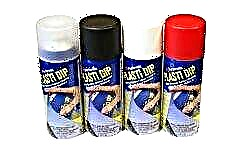

The content of the article:
- What is Plasti Dip
- Pros and cons of liquid rubber
- Application process
- Plastidip price
Plasti Dip is a liquid rubber, as many say rubber paint or better known as plastidip. Modern technologies of painting and tuning in the direction of beauty exceed all expectations. The matt shade of the body and individual parts is becoming more and more popular. At first they used matte paint, but as you know, the procedure is long and not cheap. A cheaper, but also high quality option is Plasti Dip liquid rubber from Performix.
In addition to a beautiful matte finish, Plasti Dip liquid rubber protects the surface well, does not allow water to pass through, protects against chips, surface abrasion and various road reagents. Let's consider in more detail the pros and cons of liquid rubber, as well as the application technology and price.
What is Plasti Dip Liquid Rubber

Plasti Dip liquid rubber from Performix is essentially rubber paint, can be sprayed in an aerosol can or in cans like paint. The range of shades is very diverse from dark to the brightest colors. As a rule, plastidip is applied to a car body, discs and other solid substrates, including plastic and individual parts.
Plasti Dip liquid rubber contains a special polymer of bitumen water emulsion. It is impossible to make such a coating at home, since it is necessary to withstand the technology, mix the components with a special method and prevent them from thickening before applying.
The first samples of Plasti Dip liquid rubber were produced only in black, over time, but thanks to progress, now you can find any shade. When compared with vinyl film, the price of plastidip is several times lower, as is the ease of application. Most often, plastidip is applied in different shades, thereby forming a pattern or multi-colored shape. Having withstood the application technology, the result is a smooth matte surface.
What are the pros and cons of Plasti Dip liquid rubber

Like any coating product, Palsti Dip Liquid Rubber has its pros and cons. Most often, the pros are indicated immediately, but the cons of the material are not always predictable.
In addition to the beautiful coating that can be obtained by applying Plasti Dip, liquid rubber also has protective properties. After application, a strong, protective, elastic film is formed. It also protects against chips, moisture, surface abrasion, various road reagents and paint fading.
There are many rumors that Plasti Dip liquid rubber reacts well enough to temperature changes and, as a result, loses its properties. This is all not true, according to the manufacturer, the temperature range that the plastidip can withstand is from -30 to +130 degrees Celsius. But as users note, these limits are much higher, especially with regard to sub-zero temperatures. According to rumors, at minus temperatures, Plasti Dip liquid rubber cracks and peels, but no, in the cold the plastidip becomes even more durable and tolerates minus temperatures well.

Positive temperature is also not terrible for Plasti Dip liquid rubber. Everything that a person is able to withstand, the plastidip will calmly withstand. According to rumors, at high temperatures, liquid Plasti Dip rubber simply flows off the surface, but as practice shows, it becomes soft, elastic, but at the same time adheres well to the surface.
Another plus of Plasti Dip liquid rubber is 100% water resistance, which means that the surface will be completely protected from water and corrosion. Considering that Plasti Dip is applied as an aerosol, it can be applied to absolutely any surface, which is many times better than vinyl or other adhesives.
Performix has been known for several years for the production of chemical products for cars, including Plasti Dip liquid rubber. Therefore, during this time, a lot of reviews, opinions of the owners, and even more contradictions have been collected. As they say, theory is one thing, but practice is much more important.

As they said, where there are pluses, there is also a minus. The Plasti Dip liquid rubber from Performix did not pass it by either. The manufacturer indicates that plastidip is resistant to chemicals in the sink and must be washed under low pressure. In fact, as users note, at first the plastidip is still persistent, but especially grayish or white stripes begin to appear on black. At the same time, this is not observed on bright shades of liquid Plasti Dip rubber. As for the washing pressure, it is really better to stick to low pressure, since small scratches or chips can instantly turn into large patches. It was also indicated that Plasti Dip liquid rubber is good at protecting against chips and scratches. Alas, different factors play here, a lot depends on the situation and strength. If, for example, you take a small sliding scratch, then there may not be damage, but the blow will be from a sharp stone or other object, then damage cannot be avoided. Thus, it is necessary to take into account the strength of the damage and the degree of protection of the plastidip will depend on this.
Another disadvantage is fingerprints on the surface of the Plasti Dip liquid rubber. No matter how the manufacturer claims, those who have come across plastidip will unequivocally say that in 90% of cases the prints remain well on the surface, especially black and bright colors, where the transition from matte to glossy shade is clearly visible.

The last and most controversial nuance is how long Plasti Dip liquid rubber lasts. The main and most harmful substance for Plasti Dip liquid rubber is gasoline and all kinds of solvents, the plastidip is simply washed off like dust.
Much depends on the surface the material is applied to. If this is a car body, and the application technology is consistent, then it will definitely last a long time. But if you take rims or bumpers, which most often have a collision and the effect of various substances, then the period is significantly reduced.
It is also impossible to apply on the surface with damage (through crack or worst of all rust). Firstly, Plasti Dip liquid rubber does not adhere well, and secondly, after a while it can simply lag behind the surface. These are the main pros and cons of Plasti Dip liquid rubber. The warranty period for high-quality plastidip coating is up to two years.
How to Apply Plasti Dip Liquid Rubber

Plasti Dip Liquid Rubber can be applied either by hand with an aerosol can or with a spray bottle. To begin with, consider the technology of manual application using an aerosol can. As with any painting or surface treatment, the first step is to wash it free from dust, dirt and dry, this is at least 50% of your success in working with Plasti Dip liquid rubber.
The surface must be perfectly dry and free of the smallest dust particles, therefore, this process is recommended to be carried out in closed rooms. Otherwise, Plasti Dip liquid rubber will not adhere to the surface or dirt and dust on the surface will be clearly visible.
We can't even talk about applying Plasti Dip liquid rubber with a paint brush, as you will simply ruin the car. Considering the properties of Plasti Dip liquid rubber, it doesn't matter what color your surface is, and what color it will be repainted. After the surface has completely dried, it is necessary to degrease it. Usually a solvent or acetone is used, it will depend on how well the liquid Plasti Dip rubber adheres to the surface.

An equally important step is to close all open areas that should not be painted over with Plasti Dip liquid rubber. To do this, you can use paper tape, film, or pieces of paper. In a word, everything that can smoothly and without problems close certain destinies that will not be painted.It should be noted that such painting does not require disassembly of individual parts of the car body. If there are straight lines (moldings, glass or other flatness) then glue with the same straight line.
If the car's light-alloy disks are being painted, then it is necessary to cover the brake discs with a film, or even better, completely remove the disc from the car and seal the rubber with a film.
Now the most crucial moment is the application of Plasti Dip liquid rubber to the surface. It is recommended to apply in several layers, at a distance of 13-16 cm from the surface, while maintaining small intervals between layers. And so, the first layer of plastidip should be of such thickness that the original shade of the surface is visible. This will act as a bonding layer between the Plasti Dip liquid rubber and the application surface. After processing, we wait about 15 minutes for the plastidip layer to dry out.

Apply the second layer of Plasti Dip liquid rubber, it should be of such thickness that the original color of the surface is not visible, but also thin enough. Subsequent coats should be a little thicker, but do not overdo it as you may end up with a glossy finish. It is best to spray Plasti Dip liquid rubber at different angles to obtain an even layer over the entire surface.
After applying the last layer of Plasti Dip liquid rubber, you need to wait at least 30-40 minutes and remove the excess that has fallen on the unnecessary surface. Those who have used Plasti Dip liquid rubber are advised to leave it to dry for 24-48 hours after all procedures, so the rubber adheres well to the surface.
From the little secrets of painting with Plasti Dip liquid rubber, we can say that the closer to the surface you spray, the smoother the surface will turn out, the further away - the more structured the surface will be. But if you keep the spray can too far from the surface to be treated, then in the future it will be very difficult to separate such a coating from the original surface.

Practice on a small area before applying Plasti Dip Liquid Rubber. The treated surface should not be washed immediately or cleaned for several days. Remember to hold the spray can upright, and when you are finished applying and there is still liquid Plasti Dip rubber, turn the spray upside down and spray several times on any surface. This way, you can reuse the aerosol without drying out.
An equally important temperature indicator of the environment, when working with liquid Plasti Dip rubber, one should avoid too high or low temperatures, as well as high humidity.

If after applying the liquid Plasti Dip rubber to the surface you find damage, do not worry, it is enough to remove, clean the damaged area and reapply the plastidip to the surface, following the above technology. For this reason, it is necessary to take an aerosol of Plasti Dip liquid rubber with a margin.
According to the manufacturer Performix, the warranty period for Plasti Dip liquid rubber is 1-2 years, but there are cases of a longer period. Removing Plasti Dip liquid rubber from the surface is easy enough. It is necessary to pick up any place with the plastidip and pull on the formed hold.
As you can see, even an inexperienced person can apply Plasti Dip liquid rubber to any surface; it is enough to follow the technology and application rules step by step. The result is a matte finish in the selected shade.
Plasti Dip liquid rubber price

The price of plastidip or the more well-known liquid rubber Plasti Dip depends on the chosen capacity and type of application. In our case, these are aerosol cans, and must be applied manually.
In many stores, an aerosol can of Plasti Dim liquid rubber costs about 3980 rubles, but in the online store it can be purchased for 1990 rubles, for a promotion you can often take two aerosol cans for the price of one. If you buy Plasti Dip liquid rubber in large cans, then it will be ten times more expensive, for example, from $ 100 per liter.
At first glance, the technology of applying Plasti Dip liquid rubber is very difficult, but after studying the whole process, everything turns out to be many times easier. Therefore, it is worth carefully reviewing the stages of work and once try to independently apply Plasti Dip liquid rubber on a small surface.
Plastidip strength test:











